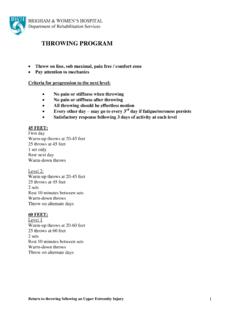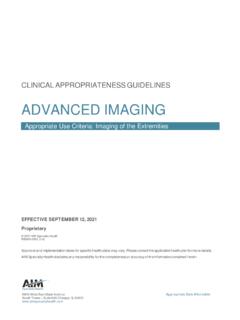Transcription of Shoulder Reverse TSA Protocol - Boston Shoulder Institute
1 Department of Rehabilitation Services Reverse Total Shoulder Arthroplasty Protocol Copyright 2011 The Brigham and Women's Hospital, Inc. Department of Rehabilitation Services. All rights reserved. 1 Reverse Total Shoulder Arthroplasty Protocol : General Information: Reverse or Inverse Total Shoulder Arthroplasty (rTSA) is designed specifically for the treatment of glenohumeral (GH) arthritis when it is associated with irreparable rotator cuff damage, complex fractures as well as for a revision of a previously failed conventional Total Shoulder Arthroplasty (TSA) in which the rotator cuff tendons are deficient.
2 It was initially designed and used in Europe in the late 1980s by Grammont; and only received FDA approval for use in the United States in March of 2004. The rotator cuff is either absent or minimally involved with the rTSA; therefore, the rehabilitation for a patient following the rTSA is different than the rehabilitation following a traditional TSA. The surgeon, physical therapist and patient need to take this into consideration when establishing the postoperative treatment plan. Important rehabilitation management concepts to consider for a postoperative physical therapy rTSA program are: Joint protection: There is a higher risk of Shoulder dislocation following rTSA than a conventional TSA.
3 O Avoidance of Shoulder extension past neutral and the combination of Shoulder adduction and internal rotation should be avoided for 12 weeks postoperatively. o Patients with rTSA don t dislocate with the arm in abduction and external rotation. They typically dislocate with the arm in internal rotation and adduction in conjunction with extension. As such, tucking in a shirt or performing bathroom / persona hygiene with the operative arm is an especially dangerous activity particularly in the immediate peri-operative phase. Deltoid function: Stability and mobility of the Shoulder joint is now dependent upon the deltoid and periscapular musculature.
4 This concept becomes the foundation for the postoperative physical therapy management for a patient that has undergone rTSA. Department of Rehabilitation Services Reverse Total Shoulder Arthroplasty Protocol Copyright 2011 The Brigham and Women's Hospital, Inc. Department of Rehabilitation Services. All rights reserved. 2 Function: As with a conventional TSA, maximize overall upper extremity function, while respecting soft tissue constraints. ROM: Expectation for range of motion gains should be set on a case-by-case basis depending upon underlying pathology.
5 Normal/full active range of motion of the Shoulder joint following rTSA is not expected. Reverse Total Shoulder Arthroplasty Biomechanics The rTSA prosthesis reverses the orientation of the Shoulder joint by replacing the glenoid fossa with a glenoid base plate and glenosphere and the humeral head with a shaft and concave cup. This prosthesis design alters the center of rotation of the Shoulder joint by moving it medially and inferiorly. This subsequently increases the deltoid moment arm and deltoid tension, which enhances both the torque produced by the deltoid as well as the line of pull / action of the deltoid.
6 This enhanced mechanical advantage of the deltoid compensates for the deficient RC as the deltoid becomes the primary elevator of the Shoulder joint. This results in an improvement of Shoulder elevation and often individuals are able to raise their upper extremity overhead. Figure 1. Anterior Posterior radiograph (A) and illustration (B) of a left Shoulder with rotator cuff arthropathy. The superiorly migrated humeral head indicates rotator cuff deficiency. A B A Department of Rehabilitation Services Reverse Total Shoulder Arthroplasty Protocol Copyright 2011 The Brigham and Women's Hospital, Inc.
7 Department of Rehabilitation Services. All rights reserved. 3 Figure 2. Reverse Total Shoulder Arthroplasty Components . The prosthesis has 5 parts: the glenoid base, the glenosphere, a polyethylene cup, humeral neck, and the humeral stem. Figure 3. Anterior Posterior radiography of a right Shoulder (A) and an illustration of a left Shoulder (B) after Reverse total Shoulder arthroplasty. T B A Department of Rehabilitation Services Reverse Total Shoulder Arthroplasty Protocol Copyright 2011 The Brigham and Women's Hospital, Inc.
8 Department of Rehabilitation Services. All rights reserved. 4 Reverse Total Shoulder Arthroplasty Protocol : The intent of this Protocol is to provide the physical therapist with a guideline/treatment Protocol for the postoperative rehabilitation management for a patient who has undergone a Reverse Total Shoulder Arthroplasty (rTSA). It is by no means intended to be a substitute for a physical therapist s clinical decision making regarding the progression of a patient s postoperative rehabilitation based on the individual patient s physical exam/findings, progress, and/or the presence of postoperative complications.
9 If the physical therapist requires assistance in the progression of a postoperative patient who has had rTSA the therapist should consult with the referring surgeon. The scapular plane is defined as the Shoulder positioned in 30 degrees of abduction and forward flexion with neutral rotation. ROM performed in the scapular plane should enable appropriate Shoulder joint alignment. Shoulder Dislocation Precautions: No Shoulder motion behind back. (NO combined Shoulder adduction, internal rotation, and extension.) No glenohumeral (GH) extension beyond neutral. *Precautions should be implemented for 12 weeks postoperatively unless surgeon specifically advises patient or therapist differently.
10 Surgical Considerations: The surgical approach needs to be considered when devising the postoperative plan of care. Traditionally rTSA procedure is done via a typical deltopectoral approach, which minimizes surgical trauma to the anterior deltoid. Some surgeons perform this procedure via a superior approach, retracting the anterior deltoid from the anterior lateral one third of the clavicle. This allows for superior exposure to the GH joint between the retracted anterior deltoid and the clavicle. Upon surgical closure the anterior deltoid is sutured back to its anatomical location.







